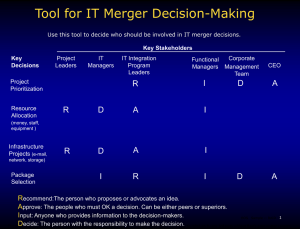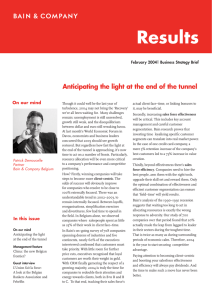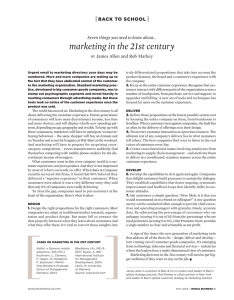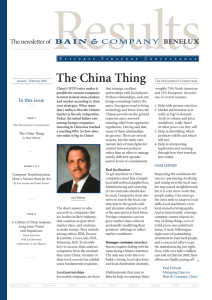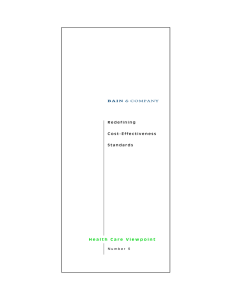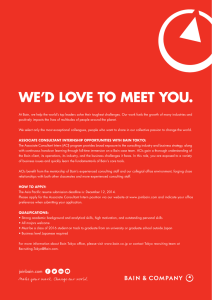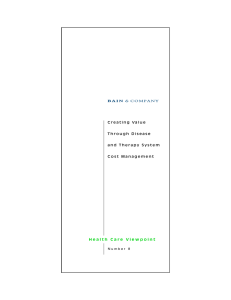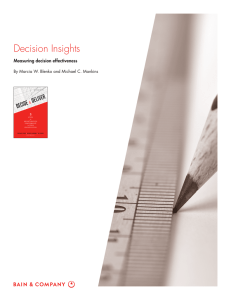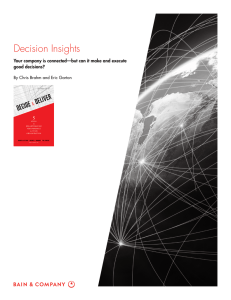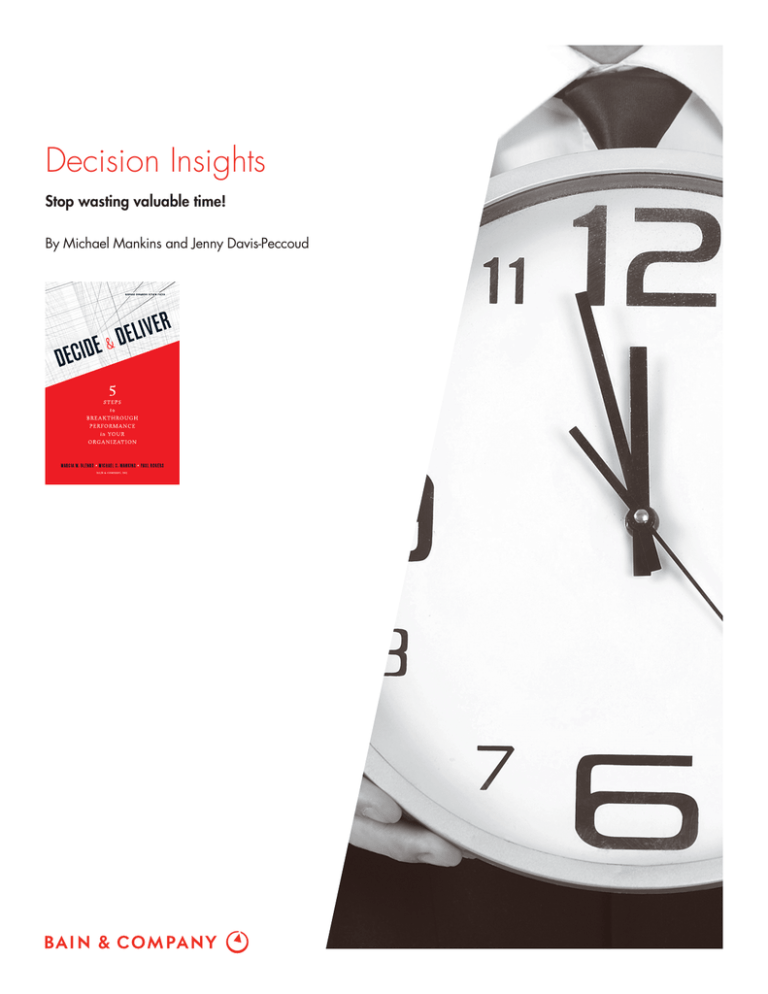
Decision Insights
Stop wasting valuable time!
By Michael Mankins and Jenny Davis-Peccoud
Stop wasting valuable time!
It’s a few days before your company’s biweekly management
meeting, and agenda items are pouring in. The CIO hopes
to review plans for an Oracle implementation. The EVP
for Europe wants to discuss some disturbing competitive trends
in her region. An executive for North America needs to present a major factory-automation proposal. The marketing
SVP wants to show some alternatives for a big multimedia
campaign, and the CEO himself hopes to discuss a revamp
of the annual budgeting process.
meetings for each purpose. The executive board of a major
European bank, for instance, once spent its twiceweekly meetings reviewing loans and discussing daily
operations. But then competition heated up, and the
bank found itself struggling to hit its targets. A new
chairman eliminated one of the weekly operations meetings and added a monthly day-long session on strategy,
where the board could make significant resource-allocation choices. The result: better, faster decisions, and
less wasted time.
Receiving a draft agenda from his assistant, the CEO reorders
it, putting operational items up front so that most of the meeting can focus on strategic issues. Once the meeting begins, however, his plan goes awry. The group has an hour-long debate
about the marketing campaign. The discussion of the Oracle
system turns into a lengthy gripe session about the IT department. Pressed for time, the group quickly greenlights the factoryautomation proposal, postpones consideration of European
competition and has an awkward, inconclusive discussion
about budgeting. People leave the meeting in a sour mood,
complaining about wasting time.
2. Focus meetings on decisions, not discussion
Simple, easily implemented changes in meeting protocol often have big effects. For example, senior management at Intel makes it standard practice to begin
every meeting with a single statement: “The purpose
of this meeting is to inform you about X, to discuss Y
and to decide on Z,” where Z is a specific, well-defined
decision. You’ll find that labeling agenda items in this
way encourages people to move the information-only
items to pre-reading materials whenever possible, leaving more time for decision making.
Top management’s time is one of a company’s scarcest
resources. The typical company’s senior executives spend
less than three hours a month working together as a team,
and usually less than three hours discussing strategic
issues. The result? Constant frustration. Poorly considered decisions. Bad investments and missed opportunities. And the trouble isn’t just at the top. Managers
throughout large organizations often find their days
eaten up by endless, unproductive meetings. They leave
work wondering where the time went.
3. Prioritize high-value items
Management author Stephen Covey famously urged
executives to distinguish between the important and the
merely urgent, and to ensure that important matters
received the attention they merit. A useful tool for identifying important decisions is a decision architecture—
essentially, a list of key decisions along each step of a
business’s value chain, prioritized by the value at stake
and the degree of management attention required. You
can create such a list for your unit or function, and then
use it as a guide for setting meeting agendas. Without it,
the urgent is likely to displace the important.
But it doesn’t need to be this way, because individual leaders can make a difference. Many have learned to manage
their meetings to get things done quickly and effectively,
with maximum output and minimal time loss. There are
seven key techniques:
4. Move items off the agenda
1. Separate operations from strategy
You also need a rigorous process for resolving issues,
including an unambiguous timetable that details when
and how team members will reach a decision and how
it will be executed. Bob Walter, the legendary founder
and former CEO of Cardinal Health, liked to refer to
Operational matters require detailed discussion and analysis. Strategy requires a big-picture, forward-looking
view. The two mindsets are different, and the two kinds
of topics mix poorly. As a leader, you can hold separate
2
Stop wasting valuable time!
delay as “the worst form of denial.” Senior managers at
his company worked under a strict decision timetable
driven from the top.
assign specific roles to each member. (R is for Recommend, A is for Agree or sign off on, D is for the decision
maker and so on.) Once the team was accustomed to
the tool, one executive said, “We go into a meeting now
and people say, ‘Who has the D?’ and ‘Who has the R?’
It streamlines everything.”
5. Demand real choices for each major decision
It’s said that whenever Henry Kissinger, the former US
secretary of state, asked his foreign policy team for alternatives, the team would always present one that led to
unconditional surrender to the Soviet Union, a second
that led to thermonuclear war and a third—the one the
team favored. Ask your teams to present real choices, not
false ones. How many times have you sat through an investment proposal knowing there was another viable
course of action but not knowing whether it had been
considered and rejected?
7. Make decisions stick
Managers at many companies waste countless hours reviewing and revisiting decisions that should have been
made only once. So make a point of summarizing the
decisions made at a meeting, along with commitments
and to-do’s for follow-up (with deadlines!). Then record
these in a decision log and review the follow-up at the
next meeting.
6. Introduce a common language for decision roles
Leaders who recognize the value of time can adopt these
practices right now. Once you do, your teams can focus
on the most important issues, consider alternatives and
make the best choices in the shortest amount of time.
And people will leave their meetings not with a sense of
frustration but with a sense of accomplishment.
The executive team of a large insurance company found
it difficult to make decisions because of the company’s
deep-rooted consensus culture. Finally the CEO introduced the RAPID® decision-rights tool, which lets a team
RAPID® is a registered trademark of Bain & Company, Inc.
Michael Mankins leads Bain’s Organization practice in the Americas and is a partner in San Francisco. He is a
coauthor of Decide & Deliver: 5 Steps to Breakthrough Performance in Your Organization (Harvard Business Review
Press, 2010). Jenny Davis-Peccoud, a partner based in London, leads the Organization practice in Europe, the
Middle East and Africa.
Copyright © 2014 Bain & Company, Inc. All rights reserved.
3
Shared Ambit ion, True Results
Bain & Company is the management consulting firm that the world’s business leaders come to when they
want results.
Bain advises clients on strategy, operations, technology, organization, private equity and mergers and acquisitions. We develop
practical, customized insights that clients act on and transfer skills that make change stick. Founded in 1973, Bain has 50 offices
in 32 countries, and our deep expertise and client roster cross every industry and economic sector. Our clients have outperformed
the stock market 4 to 1.
What sets us apart
We believe a consulting firm should be more than an adviser. So we put ourselves in our clients’ shoes, selling outcomes, not projects. We align our incentives with our clients’ by linking our fees to their results and collaborate to unlock the full potential of their
business. Our Results Delivery® process builds our clients’ capabilities, and our True North values mean we do the right thing for
our clients, people and communities—always.
For more information, visit www.decide-deliver.com
For more information about Bain & Company, visit www.bain.com


